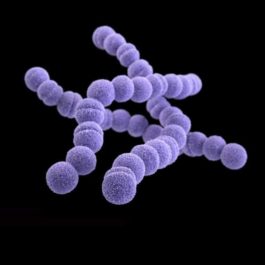

Vaxcyte, Foster City, CA, USA
www.vaxcyte.com
New vaccine could be a game-changer in the prevention of Strep Throat infections and the spread of superbugs
If successful and approved for use in patients, Vaxcyte’s (formerly SutroVax) new vaccine could prevent infections, and curb the spread of Group A Streptococcus (GAS) superbugs
Most healthy people who become infected with Group A Streptococcus (GAS) bacteria develop nothing more serious than pharyngitis, more commonly known as Strep Throat, an infection and inflammation of the pharynx, the membrane-lined cavity at the back of the throat. But GAS can also pose a serious health threat, particularly to people with weakened immune systems, when it invades the bloodstream or deeper tissues to produce severe infections, such as sepsis, necrotizing fasciitis (flesh-eating disease), and toxic shock syndrome. GAS is also the trigger for post-infectious immune-mediated rheumatic heart disease, a leading cause of mortality in the developing world.
Strep Throat is prevalent in school-age children with an estimated 600 million cases annually worldwide. As a result, GAS-related infections are a major source of antibiotic prescriptions. Currently, no vaccine exists for GAS bacteria. But CARB-X and Vaxcyte, a biotech firm in Foster City, California, USA, that specializes in best-in-class conjugate vaccines and novel complex antigen-based vaccines, are hoping to change that.
“Vaccines are powerful weapons in the global fight against drug-resistant bacteria. Vaccines not only prevent infections, they also reduce the need for antibiotics, helping to curb the spread of drug resistance,” said Kevin Outterson, Executive Director of CARB-X.
CARB-X has awarded SutroVax up to $1.64 million in non-dilutive funding with the possibility of $13.4 million more if certain project milestones are met, to develop an innovative vaccine to prevent infections caused by GAS bacteria.
The Vaxcyte effort is based upon original published research by Victor Nizet, MD, professor of pediatrics and pharmacy at University of California San Diego School of Medicine, Nina van Sorge, PharmD, PhD, a former post-doctoral fellow in Nizet’s lab and now associate professor at Utrecht University Medical Center in the Netherlands, and other scientists at UC San Diego who will collaborate on vaccine development and conduct initial testing. In 2014, Nizet, van Sorge and collaborators identified the genes encoding a molecule that defines GAS. The findings shed new light on how strep bacteria resists the human immune system and provided a new strategy for a vaccine. The patented discoveries were licensed to Vaxcyte and combined with their unique conjugation technology to construct a new vaccine approach.
Efforts to develop a GAS vaccine have been significantly hindered by complexities in how the human immune system reacts to the bacterial pathogen. Specifically, some patients with strep infections produce antibodies that cross-react with their own heart valve tissue, leading to rheumatic heart disease. Though rare in the United States, rheumatic fever remains common in some developing countries and causes significant disability and death. An important concern in GAS vaccine development is to avoid selecting bacterial antigens that could inadvertently trigger such an autoimmune reaction in humans.
Nizet, van Sorge and colleagues believe they found a way to circumvent the damaging autoimmune response triggered by strep. The strep cell wall is primarily composed of a complex molecule known as the group A carbohydrate (GAC) which, in turn, is built from repeating units of the bacterial sugar rhamnose and the human-like sugar N-acetylglucosamine (GlcNAc).
“Because GAC is universally conserved among all GAS strains and elicits protective antibodies in natural infection, it is an attractive antigen target for vaccine development,” said Nizet in an interview with UC San Diego Health when the award to Vaxcyte was announced in September 2019. “The catch has been previous research indicating that GlcNAc sugars present in GAC may be responsible for triggering production of heart-damaging antibodies in some patients.
“The fundamental advance provided by UC San Diego research was the discovery of the GAS genes that encode the machinery for GAC synthesis, and thus a way to eliminate the pathogen’s ability to add GlcNAc sugars on the molecule.”
Vaxcyte is taking this important conserved antigen, GAC, and conjugating it to a carrier protein using its site-specific conjugation technology to ensure that the critical immunogenic epitopes on not only the antigen, but also the protein carrier are exposed to the immune system to provide a robust, durable, and boostable immune response in order to prevent GAS.
The Centers for Disease Control and Prevention (CDC) reports that in the United States alone, approximately 11,000 to 13,000 cases of invasive GAS disease (cellulitis with blood infection, necrotizing fasciitis, pneumonia, and toxic shock syndrome) occur each year, from which, between 1,100 and 1,600 people die. It is estimated that in low- and middle-income countries, up to 180,000 people die from RHD each year.
Photo: Group A Streptococcus (courtesy of the CDC)
Published on October 22, 2019


